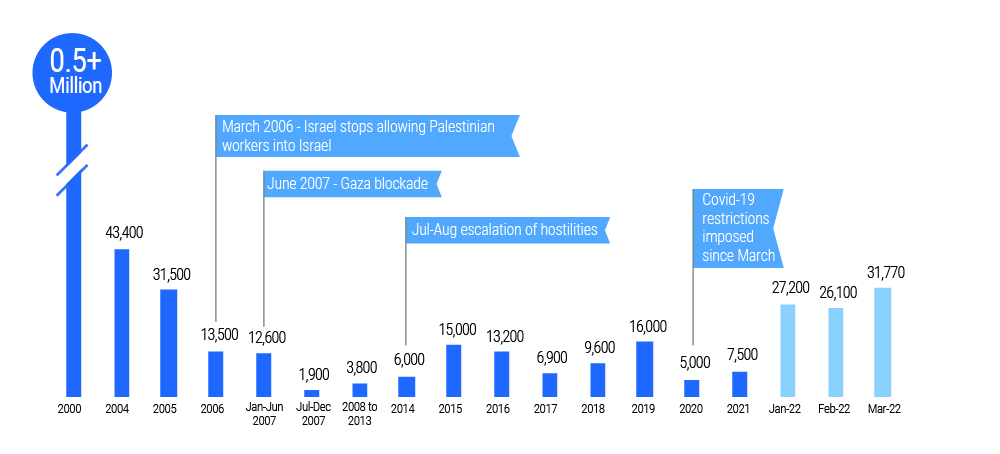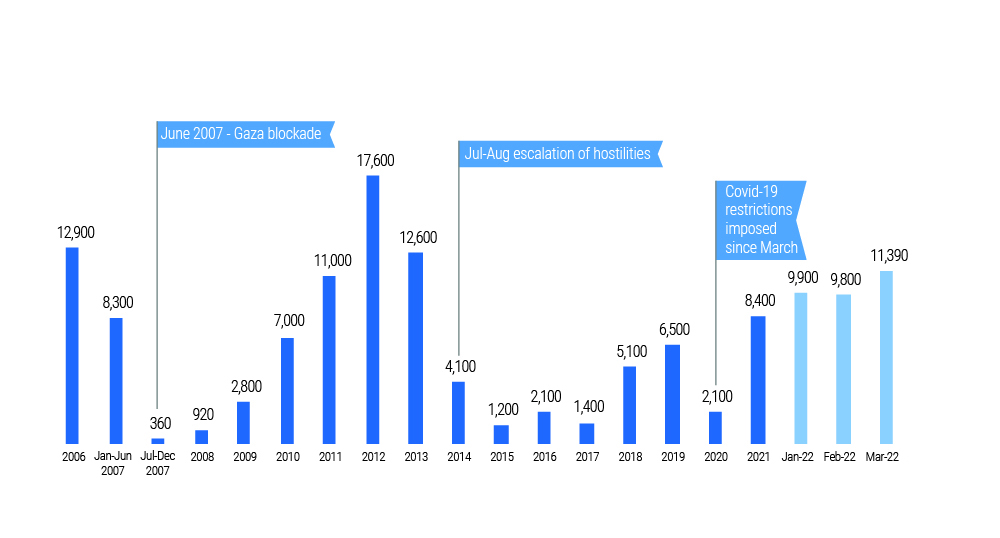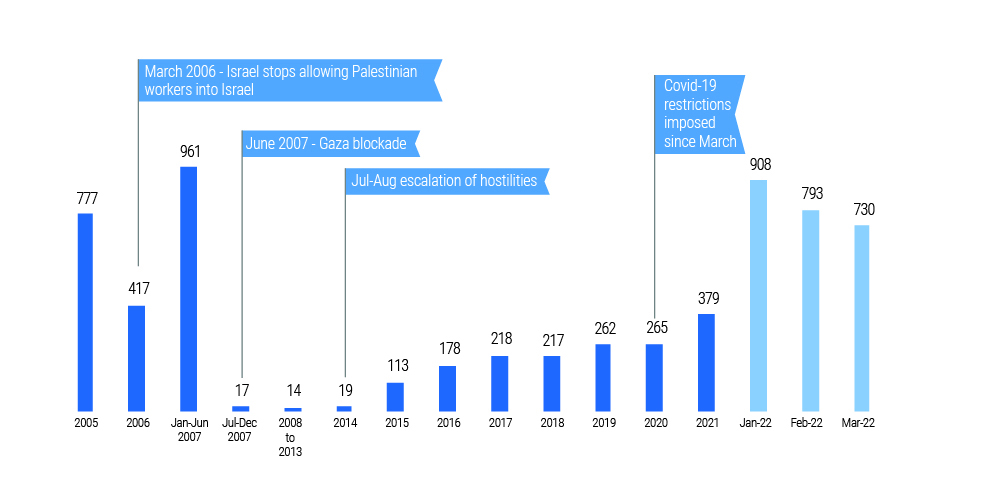Movement in and out of Gaza: update covering March 2022
Highlights
- In March 2022, the movement of people from Gaza to the West Bank, Israel and Egypt increased compared with February.
- More goods entered via Israel and Egypt, but fewer exited, compared with previous months.
Background: Longstanding restrictions on the movement of people and goods to and from Gaza have undermined the living conditions of the approximately two million Palestinian residents. Many of the current restrictions, originally imposed by the Israeli authorities in the early 1990s, were intensified after June 2007, following the Hamas takeover of Gaza when the Israeli authorities imposed a blockade. These restrictions continue to reduce access to livelihoods, essential services and housing, disrupt family life, and undermine people’s hopes for a secure and prosperous future. The situation has been compounded by the restrictions imposed by the Egyptian authorities at Rafah Crossing.
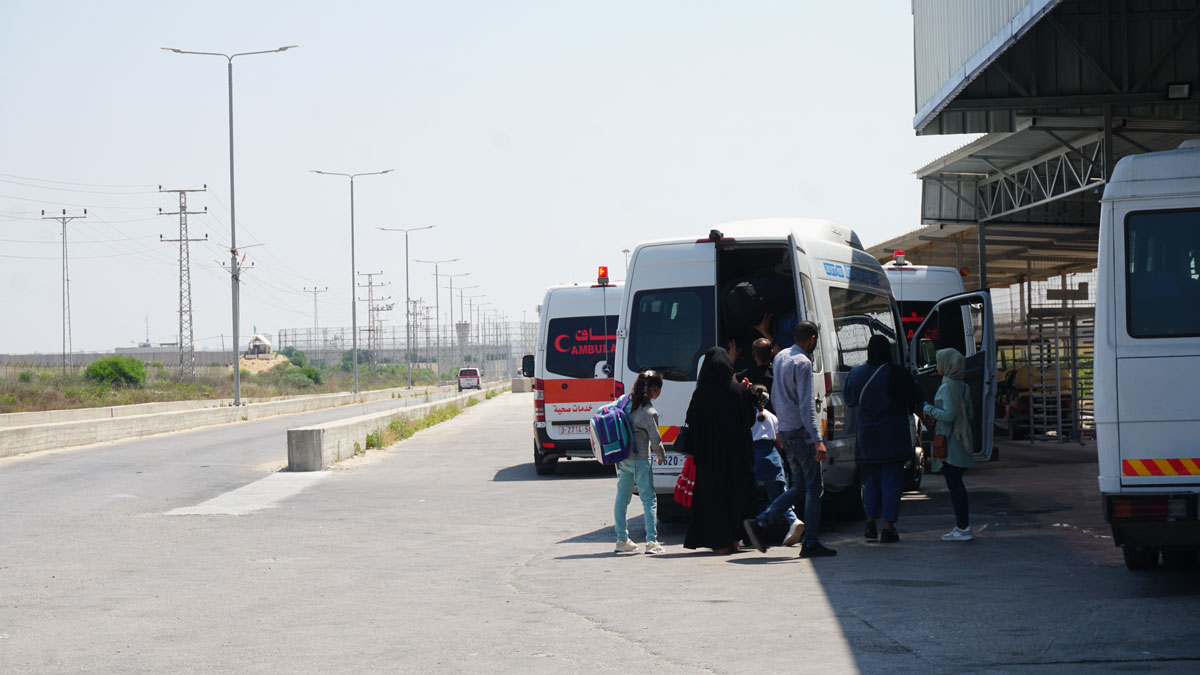
For the first time since 2007, a family was allowed to exit for a family reunion. Source OCHA OPT, June 2022
Movement of people to Israel and the West Bank
- In March, the Israeli authorities allowed nearly 31,800 exits from Gaza (in most cases, travellers exited multiple times). This was 22 per cent above the level of exits in February, and over four times more the monthly average in 2021, when COVID-19 restrictions largely applied. However, it represents only about six per cent of the volume of exits in the first half of 2000, before the imposition of the category-based restrictions.
- About 85 per cent of the exits were by Palestinians allowed out under the ‘traders’ or ‘economic needs’ permit category, most of whom are in fact employed as day labourers in Israel. The crossing of traders into Israel was halted by the Israeli authorities in March 2020, in the context of COVID-19 restrictions, and gradually resumed in the last quarter of 2021.
- Some 7 per cent of the exits were by patients referred for medical treatment in the West Bank or Israel, and their companions. A total of 1,667 exit-permit applications were submitted for medical appointments scheduled for March, of which only 65 per cent were approved on time.
Background: Palestinians are banned from leaving Gaza via Israel, including for passage to the West Bank, unless they obtain an Israeli-issued exit permit. Only those belonging to certain categories, primarily traders (including de facto daily labourers), patients and their accompaniers, and aid workers, can apply for such permits. Other people are not eligible for a permit, even if they do not pose a security risk, according to the Israeli authorities. In most cases, the Israeli authorities do not provide specific reasons for the rejection of an application. If an application is approved, the permit holder may travel through the Israeli-controlled Erez crossing, which operates during the daytime from Sunday to Thursday, and on Fridays for urgent cases and foreign nationals only.
Movement of people to Egypt
- The Egyptian authorities allowed about 11,390 exits in March (some travellers may have exited multiple times). This was 16 per cent above the allowed exits in February, and over 35 per cent above the monthly average in 2021, when COVID-19 restrictions largely applied.
- Some 520 people were denied entry to Egypt by the Egyptian authorities, compared with 370 denials in February 2022.
Background: Palestinians wishing to leave Gaza via Egypt must register with the local Palestinian authorities two to four weeks in advance. People may also apply directly to the Egyptian authorities, using the services of a private company. The procedures and decisions by both authorities lack transparency. Those approved exit through the Rafah Crossing, controlled by the Egyptian authorities, which operates from Sundays to Thursdays. The journey to Cairo via the Sinai desert is often lengthy and includes multiple stops for checks by Egyptian security forces.
Incoming goods
General goods (excluding fuel and gas)
- In March, the volume of goods entering Gaza was 36 per cent above the previous month, and 30 per cent above the 2021 monthly average. However, it was 10 per cent lower than the monthly average on the eve of the blockade in 2007, although Gaza’s population has grown by more than 50 per cent since then.
- Of the goods entering, 36 per cent were construction materials, and 29 per cent were food. About 4 per cent was humanitarian aid facilitated by international organizations, including food and medical supplies.
- Some 82 per cent of the goods entered via Israel. The volume was 33 per cent above the previous month, and 24 per cent above the monthly average in 2021.
- Of the goods entering via Israel, over 34 per cent were construction materials (mainly aggregates, cement, and steel bars). This was 26 per cent above the monthly average recorded in 2021, a trend attributable to higher reconstruction needs following the May 2021 hostilities.
- Some 18 per cent of the overall goods entered via Egypt, from which imports took place on 14 days. Their volume was 49 per cent more than in February, and about 48 per cent above the monthly average in 2021.
- Of the goods entering from Egypt, more than 40 per cent were construction materials, which are cheaper in Egypt and less difficult to import than from Israel. Most of the remaining goods were food items.
Background: Since the imposition of the blockade in 2007, the Israeli authorities have restricted the entry into Gaza of goods they consider having a dual (civilian and military) use, such as building materials, certain medical equipment , and some agricultural items. Some of these goods may be allowed entry, following a lengthy application and review process. The entry of all goods from or via Israel (including non-restricted goods) is only possible through the Kerem Shalom crossing, following prior coordination. Since 2018, goods have also entered Gaza regularly from Egypt, via the Rafah crossing, controlled by the Egyptian authorities, and then through the adjacent Salah Ad Din Gate, controlled by the local authorities.
Monthly average of incoming goods to Gaza (truckloads)
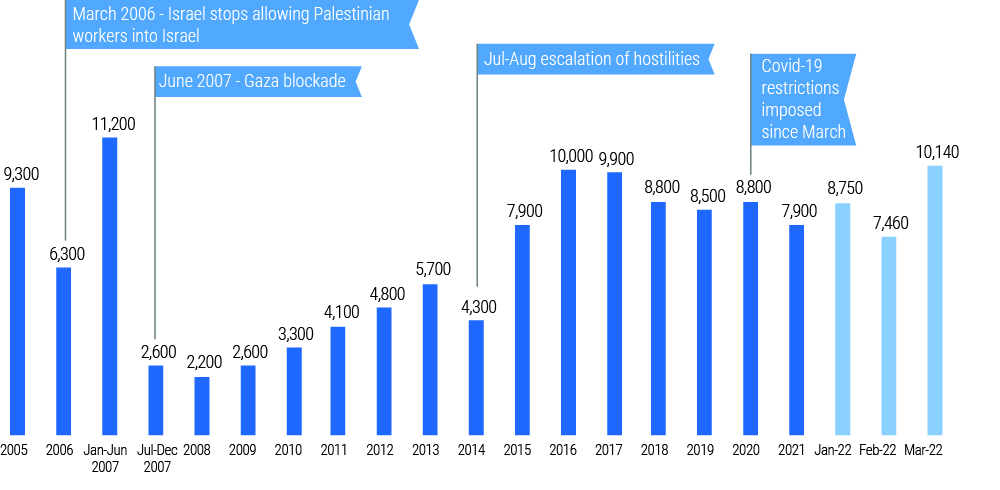
Fuel and gas
- The volumes of fuel and gas that entered Gaza from Israel and Egypt during March 2022 went up compared with the monthly average in 2021. They increased by 34 per cent for cooking gas, 25 per cent for petrol and diesel, and 33 per cent for industrial diesel for the power plant.
Outgoing goods
- In March, the Israeli authorities allowed 8 per cent fewer commodities out of Gaza, compared with February. This was 25 per cent less than the monthly average on the eve of the blockade in 2007. The recent uptrend is partially attributable to a rising demand for vegetables in Israel.
- Some 55 per cent of the outgoing goods went to the West Bank, 44.6 per cent to Israel, and 0.4 per cent to international markets. Vegetables accounted for 62 per cent and scrap iron for 23 per cent, while the remainder included textiles, fish, aluminium and used copper, and furniture.
- Another 13 truckloads exited Gaza to Egypt, carrying scrap iron.
Background: Most products traded outside Gaza are transported to markets via the Israeli-controlled Kerem Shalom crossing, where various restrictions apply. The exit of good to the West Bank and Israel, the main markets, was totally banned between 2007 and 2014, then gradually reinstated. Since August 2021, certain goods have been exported to Egypt via the Salah Ad Din gate and Rafah crossing.
Data source: Ministry of National Economy in Gaza. More data: ochaopt.org/data/crossings
